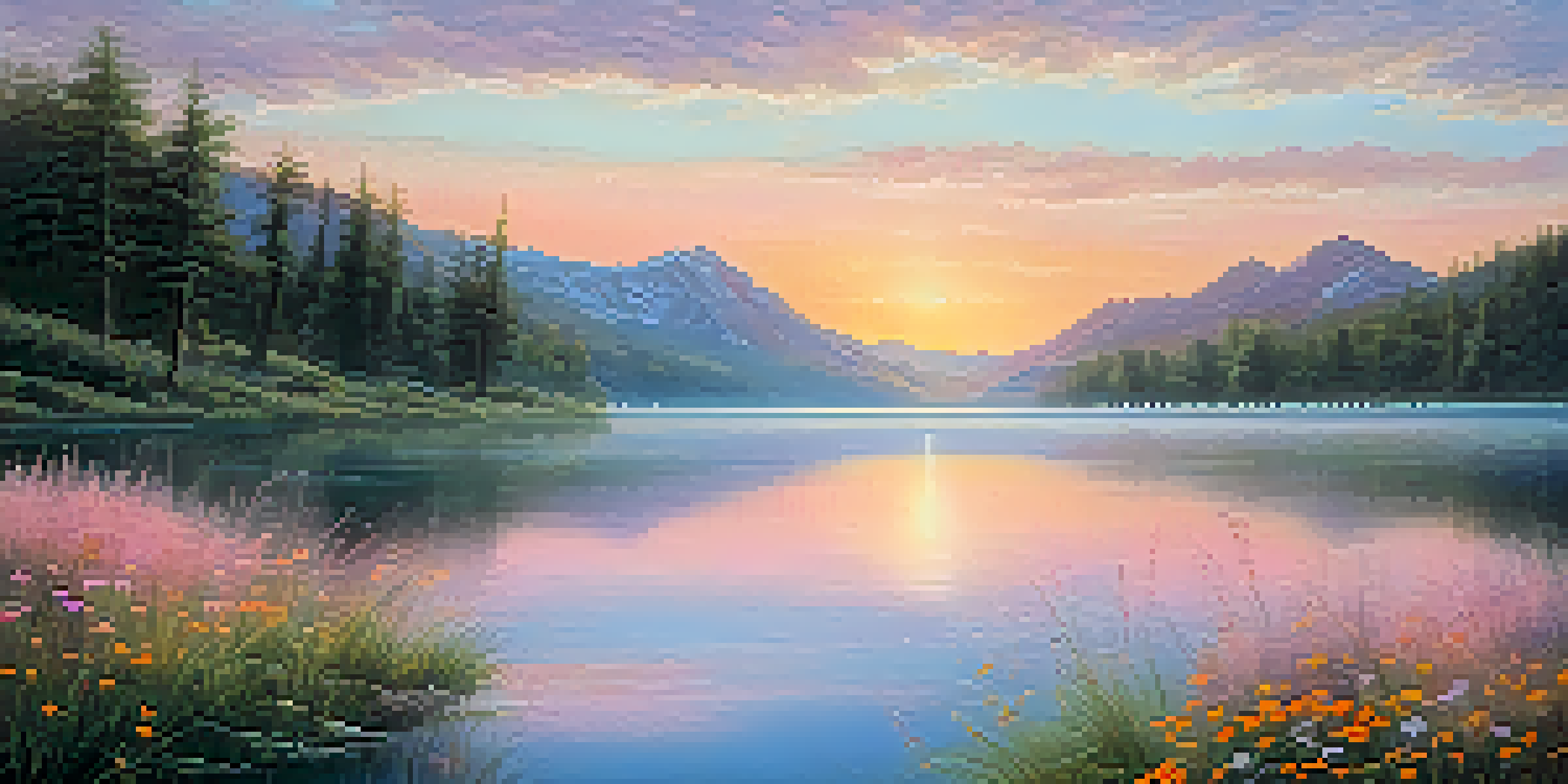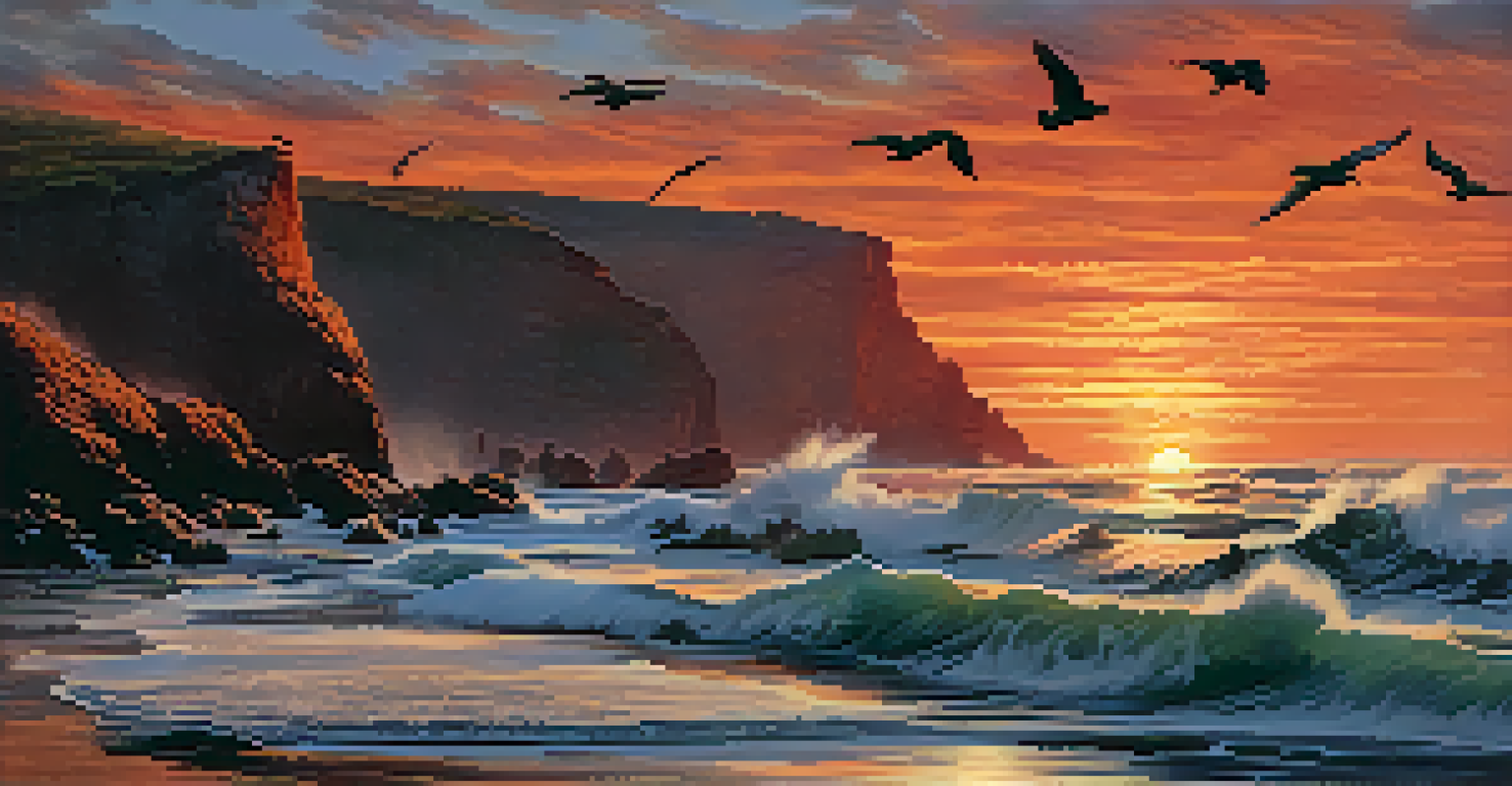Nature as Canvas: The Impact of Landscape on Art Forms

The Interplay Between Nature and Art Throughout History
From the dawn of human creativity, nature has been a muse for artists. Cave paintings often depicted animals and landscapes, illustrating our ancestors' deep connection to their environment. This relationship continued through the ages, with movements like Romanticism celebrating the beauty of untamed nature. Artists like J.M.W. Turner captured the sublime power of landscapes, reflecting how the natural world influences our emotions and perceptions.
Art is the most beautiful of all lies.
In the Impressionist era, artists such as Claude Monet sought to capture the fleeting effects of light in outdoor settings. They painted en plein air, which means 'in the open air,' directly responding to the shifting qualities of natural light. This shift in technique not only changed how landscapes were depicted but also encouraged a more personal interpretation of nature. Such practices highlight the evolving relationship between artists and their environments throughout history.
Today, this interplay remains strong as contemporary artists draw inspiration from diverse landscapes. Whether through abstract interpretations or realistic portrayals, nature continues to offer a rich canvas for creative expression. As we navigate environmental challenges, art also serves as a powerful tool for raising awareness, reminding us of the intrinsic connection we share with the natural world.
The Role of Landscape in Different Art Forms
Landscape serves as a vital element across various art forms, from painting and photography to literature and film. In visual arts, landscapes can evoke emotions, set the stage for narratives, or symbolize broader themes, such as freedom or isolation. For example, Ansel Adams' photography immortalizes the grandeur of American landscapes, while also advocating for conservation efforts. His images remind us that the beauty of nature is worthy of preservation.

In literature, authors often use landscapes to reflect characters' inner journeys. Think of the stark, desolate moors in Emily Brontë's 'Wuthering Heights,' which mirror the tumultuous emotions of its characters. Similarly, in film, sweeping landscape shots can create a sense of place and mood, enhancing storytelling. Movies like 'The Secret Life of Walter Mitty' showcase breathtaking landscapes that inspire adventure and self-discovery.
Nature Inspires Artistic Expression
Throughout history, artists have drawn inspiration from nature, using it as a muse to reflect emotions and societal values.
Even in music, landscapes can influence composition and lyrics. Many songwriters draw from their surroundings, crafting melodies that resonate with the feelings evoked by specific places. This cross-disciplinary influence illustrates how landscapes are not just backdrops but integral components that shape the narrative and emotional tone across artistic mediums.
Nature's Influence on Artistic Techniques and Styles
The natural environment has significantly impacted the techniques and styles artists employ. For instance, the use of vibrant colors in Impressionism was inspired by the observation of natural light and its effects on landscapes. Artists experimented with quick brush strokes to capture the essence of a scene rather than its details. This approach not only changed the dynamics of art but also encouraged viewers to engage with the artwork on a sensory level.
The earth has music for those who listen.
Similarly, the rise of outdoor painting in the 19th century prompted artists to innovate with portable easels and paints. This mobility allowed them to create more spontaneous and authentic representations of nature. Techniques like plein air painting brought a fresh perspective, allowing artists to embrace imperfection and the transient beauty of the moment. The result was a more dynamic and lively portrayal of landscapes.
Today, many contemporary artists continue to explore and innovate using natural materials and methods. From eco-art that incorporates organic elements to digital art that transforms landscape photography, the influence of nature on artistic techniques remains strong. This ongoing evolution underscores how landscapes not only inspire creativity but also challenge artists to adapt and rethink their approaches.
Cultural Perspectives on Landscape in Art
Cultural background plays a significant role in how landscapes are perceived and represented in art. Different cultures have their unique relationships with nature, shaping artistic expressions that reflect those values. For instance, in Japanese art, landscapes are often depicted with an emphasis on harmony and balance, as seen in the traditional Ukiyo-e prints. This illustrates a deep respect for nature and its integrated role in daily life.
In contrast, Western landscapes have often portrayed the natural world as a source of inspiration and awe, sometimes emphasizing human dominance over nature. The American frontier, for example, has been romanticized in numerous artworks, highlighting themes of exploration and conquest. This dynamic reveals how cultural narratives influence not only the content but also the intent behind landscape art.
Art as Environmental Advocacy
Contemporary artists are increasingly using their work to raise awareness of environmental issues, highlighting the fragility of natural landscapes.
Moreover, indigenous cultures frequently incorporate landscape elements into their art, emphasizing spiritual connections and ancestral ties to the land. This approach fosters a deeper understanding of the environment, reminding us that art can serve as a bridge between culture, identity, and nature. By examining these cultural perspectives, we gain insight into the diverse ways landscapes are woven into the fabric of artistic expression.
The Therapeutic Power of Nature in Art
Engaging with nature through art can have profound therapeutic effects. Studies have shown that spending time in natural settings can reduce stress and enhance well-being. Artists often find solace and inspiration in natural surroundings, using their work as a form of meditation. This connection fosters mindfulness, allowing them to immerse themselves fully in the beauty of their environment.
Additionally, art therapy has emerged as a powerful tool for healing, particularly in natural settings. Participants often create artworks inspired by their surroundings, which can facilitate emotional expression and processing. Nature-based art therapy sessions encourage individuals to explore their feelings while engaging with the beauty of the outdoors. This holistic approach underscores the therapeutic benefits of combining art and nature.
Furthermore, creating art in nature can also foster a sense of community. Collaborative projects, such as community murals or eco-art installations, bring people together to celebrate their local landscapes. These shared experiences not only promote artistic expression but also strengthen bonds among individuals, reinforcing the idea that nature can be a unifying force through art.
Environmental Concerns and Art's Role in Advocacy
As environmental issues become increasingly pressing, artists are using their platforms to advocate for change. Art has the power to raise awareness and provoke thought, making it an effective tool for environmental activism. Many contemporary artists incorporate themes of sustainability and conservation into their work, drawing attention to the fragility of our natural landscapes. Through powerful imagery, they inspire audiences to reflect on their relationship with the environment.
For example, projects like the 'Ice Watch' installation, where blocks of ice are placed in urban settings, aim to highlight climate change and its impact on glacial landscapes. Such works challenge viewers to confront uncomfortable realities while fostering a sense of urgency for action. By situating art within environmental contexts, artists create a dialogue that encourages reflection and mobilization.
Evolving Techniques in Landscape Art
Artists continuously innovate their techniques and styles, adapting to new technologies and methods while embracing the beauty of the natural world.
Moreover, eco-art movements emphasize the importance of using sustainable practices in artistic creation. Artists are increasingly opting for eco-friendly materials and methods that respect the environment. This shift not only reflects a growing awareness of ecological issues but also sets an example for responsible creativity. By intertwining art and environmental advocacy, artists contribute to a broader conversation on the importance of protecting our planet.
The Future of Landscape in Art: Trends and Innovations
The future of landscape art is poised for exciting developments as technology and innovation continue to evolve. Digital art forms, such as virtual reality and augmented reality, are providing new ways to explore and interact with landscapes. Artists are using these tools to create immersive environments that allow viewers to experience nature in entirely new dimensions. This fusion of technology and nature offers endless possibilities for artistic expression.
Moreover, the rise of social media has transformed how landscapes are shared and perceived. Platforms like Instagram have given artists a global audience, allowing them to showcase their work and connect with others passionate about nature. This democratization of art fosters collaboration and exchange, leading to innovative interpretations of landscapes that reflect diverse perspectives.

As we navigate the challenges of the modern world, the role of landscape in art will likely continue to evolve. Artists will increasingly draw from environmental concerns, cultural narratives, and technological advancements to create meaningful works that resonate with audiences. Ultimately, the relationship between nature and art remains a dynamic and essential part of our collective human experience.